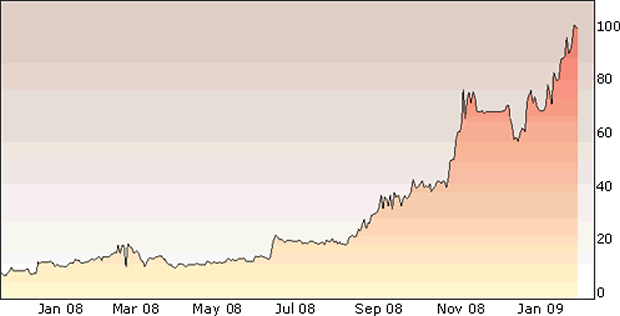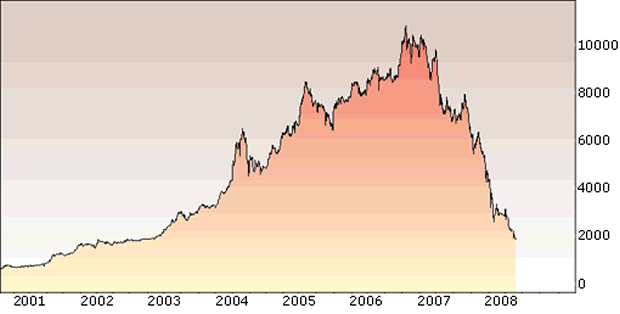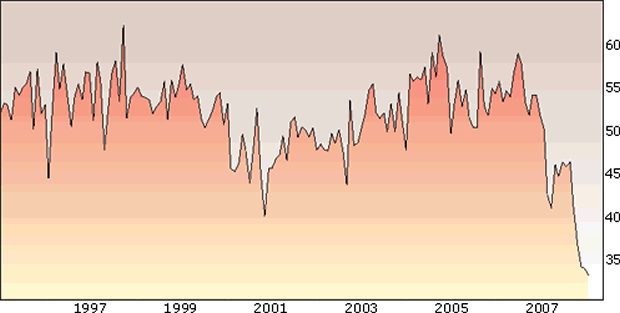World Economy Faces Credit Catastrophe, Eastern Europe in Meltdown
Economics / Recession 2008 - 2010 Feb 28, 2009 - 01:02 PM GMT Mike Larson Writes: Three market developments keeping me up at night - I'm a worrier by nature. I can't help it. My job is to peer around the corner, figure out what's next, and most importantly, discern what can really go WRONG in the economy and the markets.
Mike Larson Writes: Three market developments keeping me up at night - I'm a worrier by nature. I can't help it. My job is to peer around the corner, figure out what's next, and most importantly, discern what can really go WRONG in the economy and the markets.
And right now, I see three troubling developments that are keeping me up at night. These problems aren't front-page news … yet. But they are circling in the background and threatening to explode into the headlines — derailing the market in the process. I suggest you sit up and take notice. I sure am.
More below …
Troubling Development #1 —
Credit quality is worsening … and I'm not talking
about home mortgages or credit cards
We all know that the private credit markets are in disarray. Delinquency and default rates are soaring on credit cards, home mortgages, auto loans, and more. The cost of insuring bonds consisting of those kinds of loans has risen substantially, and losses on those bonds have been rising smartly.
The U.S. government — and its counterparts overseas — are responding very aggressively with bailouts, bank rescues, interest rate cuts, and rampant money printing. Many advocates of these policies would have you believe there will be no consequences from these actions.
But the market is sending a different message. Indeed, all of the largesse is starting to have a real impact on the perceived credit quality of the countries involved.
In other words, forget about PRIVATE credit quality. SOVEREIGN credit quality is coming into question. Just look at this chart …

If this were a stock, it'd be one you'd want to own … right? Unfortunately, it's not a stock. This chart actually shows the cost of buying insurance against a U.S. government debt default in the Credit Default Swap (CDS) market.
It now costs professional bond investors 98 basis points to buy that protection, up 14-fold from just 7 basis points in late 2007. That translates into $9,800 per $1 million of U.S. debt versus $700 previously.
Granted, that's pocket change when compared to the cost of insuring the 10-year debt of troubled corporate borrowers, like a General Motors. But again, it's the trend that matters — and the trend here is decidedly bearish.
I started talking about this development months ago. This week, I heard someone on CNBC discussing it … for the very first time.
Rising default insurance costs were LEADING indicators of last fall's stock market meltdown. And if default insurance costs continue to rise, I suspect it'll be bearish for long-term U.S. Treasury prices and bearish for stocks as well.
So be sure to watch this trend!
Troubling Development #2 — Eastern Europe melting down
You want to know which other leading indicator told me the U.S. market was in huge trouble last year?
The meltdown in Iceland. Yes, Iceland!
 |
| Iceland's mounting problems helped set off a credit and stock market hurricane. |
When the rest of Wall Street was looking the other way, I couldn't help but notice this small country's mounting problems. Iceland's currency was tanking, its stock market was coming under severe pressure, and concern about the country's external debt burden — and its ability to pay back those debts — was soaring.
Turns out Iceland was the proverbial butterfly, whose flapping wings helped set off a credit and stock market hurricane. And these days, those same kinds of troubling winds are starting to blow in the Baltic republics, the former Soviet satellite states and elsewhere in Eastern Europe.
Just consider the following …
![]() In Latvia , their currency, the lats, has been losing value against the euro amid increased credit concerns. Standard & Poor's has cut the country's credit rating down to junk territory, going from BBB- to BB+. The Latvian economy is collapsing at a 10%+ rate, forcing it to seek $9.6 billion in aid from the International Monetary Fund.
In Latvia , their currency, the lats, has been losing value against the euro amid increased credit concerns. Standard & Poor's has cut the country's credit rating down to junk territory, going from BBB- to BB+. The Latvian economy is collapsing at a 10%+ rate, forcing it to seek $9.6 billion in aid from the International Monetary Fund.
![]() In the Ukraine , things are bad and getting worse. The country's currency, the hryvnia, has lost half its value against the dollar in the past several months. S&P just slashed the Ukraine's sovereign credit rating to CCC+ from B, and market participants are worried its $16.4 billion November bailout from the IMF won't be enough to stop the bleeding.
In the Ukraine , things are bad and getting worse. The country's currency, the hryvnia, has lost half its value against the dollar in the past several months. S&P just slashed the Ukraine's sovereign credit rating to CCC+ from B, and market participants are worried its $16.4 billion November bailout from the IMF won't be enough to stop the bleeding.
![]() Meanwhile, Serbia is seeking as much as $2 billion in IMF aid. Concern about Romania's foreign-currency debt is driving its currency down. And Poland's zloty is plunging amid a sharp economic decline. I'm seeing industrial production fall there at the fastest rate since the country abandoned Communism two decades ago.
Meanwhile, Serbia is seeking as much as $2 billion in IMF aid. Concern about Romania's foreign-currency debt is driving its currency down. And Poland's zloty is plunging amid a sharp economic decline. I'm seeing industrial production fall there at the fastest rate since the country abandoned Communism two decades ago.
Now you might think it doesn't matter that the Warsaw Stock Exchange WIG Index is down 56% from a year ago. Or that the Bucharest Exchange Trading Index has plunged 76% (and 82% from its July 2007 high, as this cliff-diving chart shows).

But considering the interconnectedness of world markets — and the lesson of last year — that kind of thinking could prove dangerous. These budding crises could matter a whole bunch to U.S. investors, and it makes sense to pay close attention.
Troubling Development #3 —
Rapid deterioration in commercial
real estate continues apace
Empty buildings. For sale signs everywhere. Idled cranes and fenced-off lots. Bright orange eviction notices plastered to front doors. No, I'm not talking about what's going on in the residential real estate market. I'm talking about what's happening in the COMMERCIAL side of the business.
We're seeing commercial property sales dry up. We're seeing issuance of commercial mortgage backed securities (CMBS) plunge — dropping 95% last year. We're seeing CMBS delinquency rates rise quickly, with S&P suggesting they'll triple this year. And we're seeing vacancy rates surge, sublease space being dumped on the market, and rents declining.
Next up: Plunging commercial construction activity …
You can tell that's coming by looking at leading indicators like the American Institute of Architects index. This index, which tracks how much building design and planning work architects are getting, dropped to 33.3 in January from 34.1 in December. That's the lowest level ever for the index, which dates back to 1995.

As construction spending slumps, it's going to be one more force dragging down the U.S. economy. And as commercial real estate loan performance deteriorates, it's going to be yet another huge black hole for the banking and lending industries.
Bottom line: I'm still having a hard time being bullish on this market. And I still think more downside looms.
Until next time,
Mike
P.S. Don't forget that in between your weekly Money and Markets updates, you can get my very latest market insights at my blog. You can also sound off on everything that's happening in the interest rate and real estate worlds. Just click over to http://blogs.moneyandmarkets.com/interest-rate-roundup .
This investment news is brought to you by Money and Markets . Money and Markets is a free daily investment newsletter from Martin D. Weiss and Weiss Research analysts offering the latest investing news and financial insights for the stock market, including tips and advice on investing in gold, energy and oil. Dr. Weiss is a leader in the fields of investing, interest rates, financial safety and economic forecasting. To view archives or subscribe, visit http://www.moneyandmarkets.com .
Money and Markets Archive |
© 2005-2022 http://www.MarketOracle.co.uk - The Market Oracle is a FREE Daily Financial Markets Analysis & Forecasting online publication.



